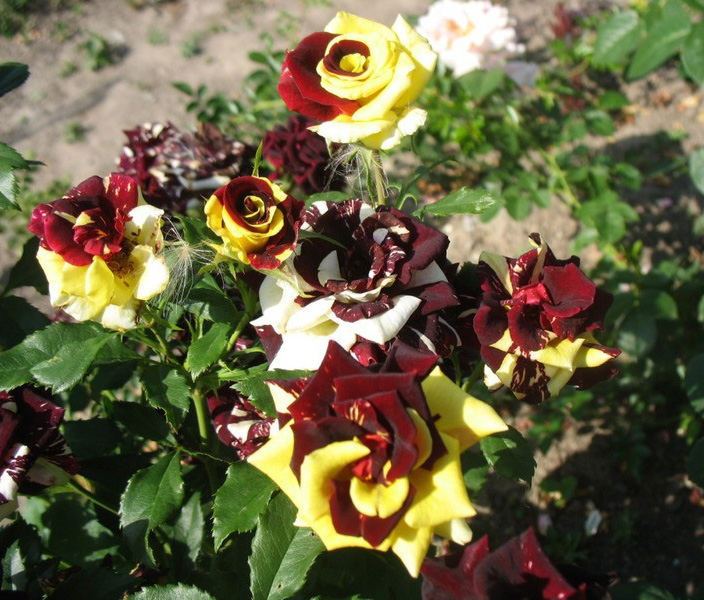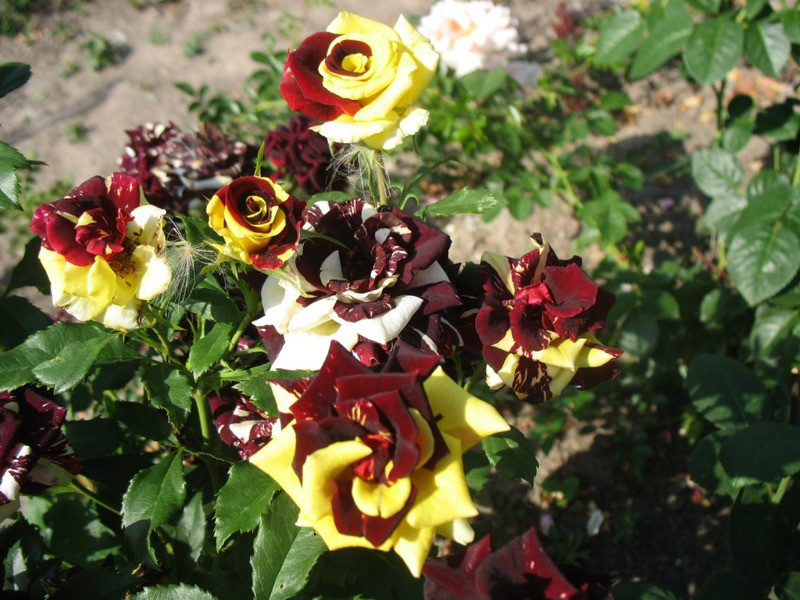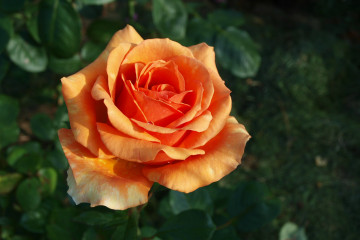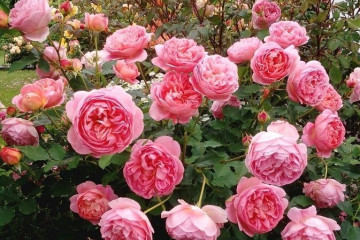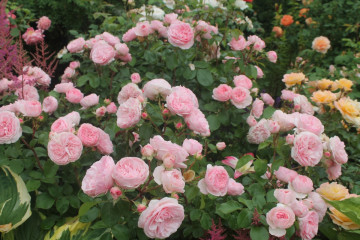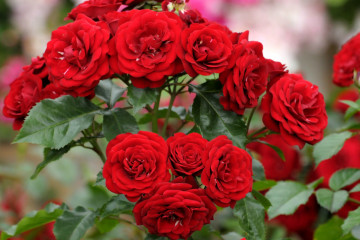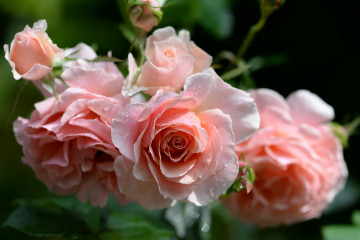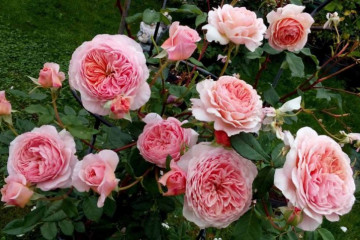Rosa Hocus pocus (Hocus pocus) - description of varietal culture
Content:
Rose bushes, on which striped-spotted flowers flaunt in an unusual color scheme, look very impressive and tempting. These are not fictional flowers, these are hocus pocus roses. The hybrid variety amazes with its ideal forms and unusual appearance. It is rightfully considered one of the amazing varieties and is widely appreciated among flower growers.
Rosa Hocus pocus - what is this variety, history of creation
The variety was bred in 2000 by German breeders from W. Kordes & sons. The variety BlackBeauty, which also appeared thanks to the Cordes company, participated in the creation of the hybrid. There are still disputes over its affiliation. Some breeders claim that this rose belongs to floribunda, others consider it part of the hybrid tea family.
Appearance and description
The bush is small in size. An adult plant grows up to 60-70 cm in height and about 30-40 cm in diameter. Shoots are strong, upright, densely covered with large leaves. Most often, one bud grows on one stem. In some cases, a whole inflorescence appears, consisting of 3-5 flowers.
During flowering, up to 15 roses bloom on one bush. The variety is characterized by high productivity. On a plot of 1 sq. m can bloom up to 250 flowers per year. The buds themselves are small, with a blossoming flower no more than 7 cm in diameter. The surface of the petals is velvety to the touch. The color is represented by the main color of wine-red and yellow spots or stripes.
Advantages and disadvantages of the variety
Hocus pocus rose is popular among flower growers not only because of the unique appearance of the flowers, but also due to other advantages, including:
- flowering in the second season after planting;
- high frost resistance, allowing to endure winters up to 20-23 ℃ below zero without organizing a shelter;
- high immunity against powdery mildew;
- sufficiently high resistance to black spot;
- good preservation of flowers after cutting.
Despite a number of undeniable advantages, the variety has disadvantages:
- susceptibility to aphids;
- poor tolerance for rainy summer.
Use in landscape design
If the purpose of breeding is to obtain a variety of the bouquet direction, then due to the small peduncles and the inconvenient location of the buds, Hocus pocus is increasingly used in landscape design.
Flowers of rare beauty serve as an excellent decoration for parks and country houses. They can be grown as a stand-alone crop or be part of a whole flower arrangement. The latter option is popular.
Growing a flower, how to plant it in open ground
Planting floribunda roses Hocus pocus is produced by seedlings. But first you have to choose the right place for the flower. The best option would be a sunny and well-ventilated area. It is better to choose flat or elevated places, since stagnant water and decay of the root system occur in the lowlands.
Planting is best done in the spring months, as the root system and the plant itself are better prepared for the coming winter. If you plan to plant seedlings in the fall, then you should start it no later than 3 weeks before the start of frost.
Rose prefers drained and fertile soils with moderate acidity. The finished hole should be suitable for the size of the root system. The depth is done about 50-60 cm in order to organize the drainage layer.
A mixture for planting is prepared from the following components:
- 3 parts cow dung;
- 2 parts river sand;
- the same amount of fertile soil;
- 1 part peat.
Before planting, it is recommended to lower the root system of the seedling in water at room temperature for 4-6 hours. If there are damaged and weak roots, they are removed.
Next, the seedling is vertically lowered into the hole and carefully filled up with the prepared mixture. To compact the soil, abundant watering is performed.
Plant care
In order for the seedling to take root in a new place, the first 3 weeks play a key role. At this time, its regular watering and loosening of the soil is important.
Watering rules and humidity
Rosa Hocus Pocus requires regular but moderate soil moistening. Do not overfill the plant so that water stagnates near it. Such a gross mistake can lead to rotting of the root system. The best option is to moisten the soil once every 6-8 days.
It is carried out early in the morning or in the evening after sunset to prevent burning of leaves and flowers. The best option would be to use a hose or bucket so that moisture gets strictly into the root system without affecting the ground part of the plant.
For better soil absorption, on the second day after each watering, its upper layers are loosened. The same procedure is repeated after precipitation.
Pruning and replanting
In order for the bush to have a decorative appearance, it is recommended to prune it. The optimal time for it is early spring, before bud break. The procedure is repeated in the middle of autumn and involves an almost complete cut of the bush. This makes it easier for the plant to survive harsh winters.
Roses are not transplanted as part of plant care. If you plan to change the location, the best time will be the first half of spring and mid-autumn.
Top dressing and soil quality
Tea and other varieties of roses prefer fertile soils with neutral to low acidity. For long and abundant flowering, it is recommended to complete several stages of fertilization:
- The first feeding is carried out in mid-March, when the snow cover melts.
- The second fertilizer is applied during the growing season, which is April.
- The next feeding is done during the flowering of roses.
- The final stage of fertilization is carried out in July, during the abundant flowering.
Each of the above stages involves applying fertilizers three times with an interval of 7-8 days.
Features of wintering a flower
Despite the fact that the variety has good frost resistance, it is recommended to cover it for safety. For this, most of the bush is cut, and agrofibre or spruce branches from coniferous branches are used as a shelter.
Blooming rose
Hocus pocus is a re-blooming rose variety. Its bloom begins in late spring and lasts until early autumn. In regions with hot climates, flowers are preserved until November.
Blooming buds delight with their color for 10-14 days, after a short period new ones grow. In order for the flowering to continue stably, it is necessary to remove the faded heads in a timely manner.
If you take care of the variety correctly, it will delight you with its flowering. The absence of buds on the bush is a reason to revise the care procedures and adjust them in the right direction.
Flower propagation
One way to propagate a rose bush is to divide it. To do this, in the period from late April to mid-May, an adult bush is dug up and divided into several parts with a pruner. At the same time, damaged and weak roots, leaving only healthy parts. Cutting points are processed with garden varnish. The root system is dipped in a mash of clay and manure. And only then the plant is planted in a permanent place.
Hocus pocus roses can also propagate using cuttings. Peat or rotted manure is introduced into the intended place for their planting. An adult, but still flexible shoot is selected, an incision is carefully made in its bark, then the upper part is bent to the ground.
Diseases and pests
The variety has good immunity against black spot and powdery mildew. In general, with good care, the plant rarely gets sick. In terms of insect pests, these roses are susceptible to aphids and, as a result, garden ants.
The Focus Pocus variety is a real surprise for flower growers. After all, it is impossible to predict in what color scale, and with what patterns the flowers will be in the next season. These roses are the best option for a person with a delicate taste and uniqueness.
